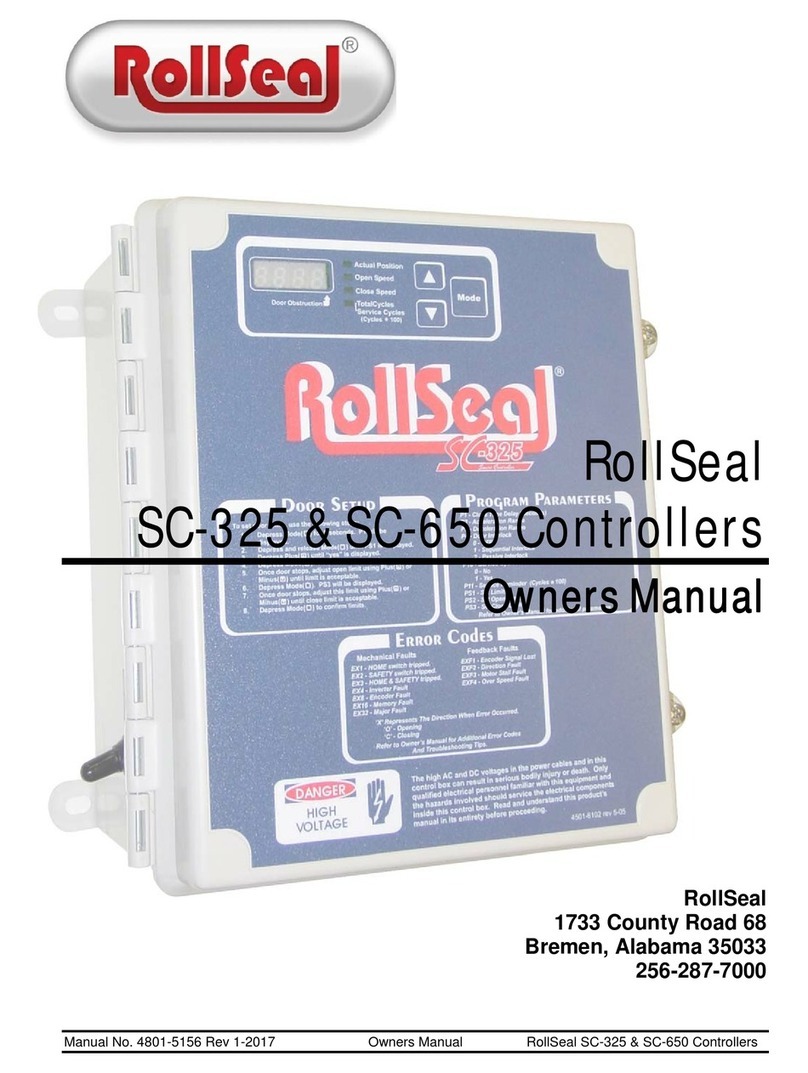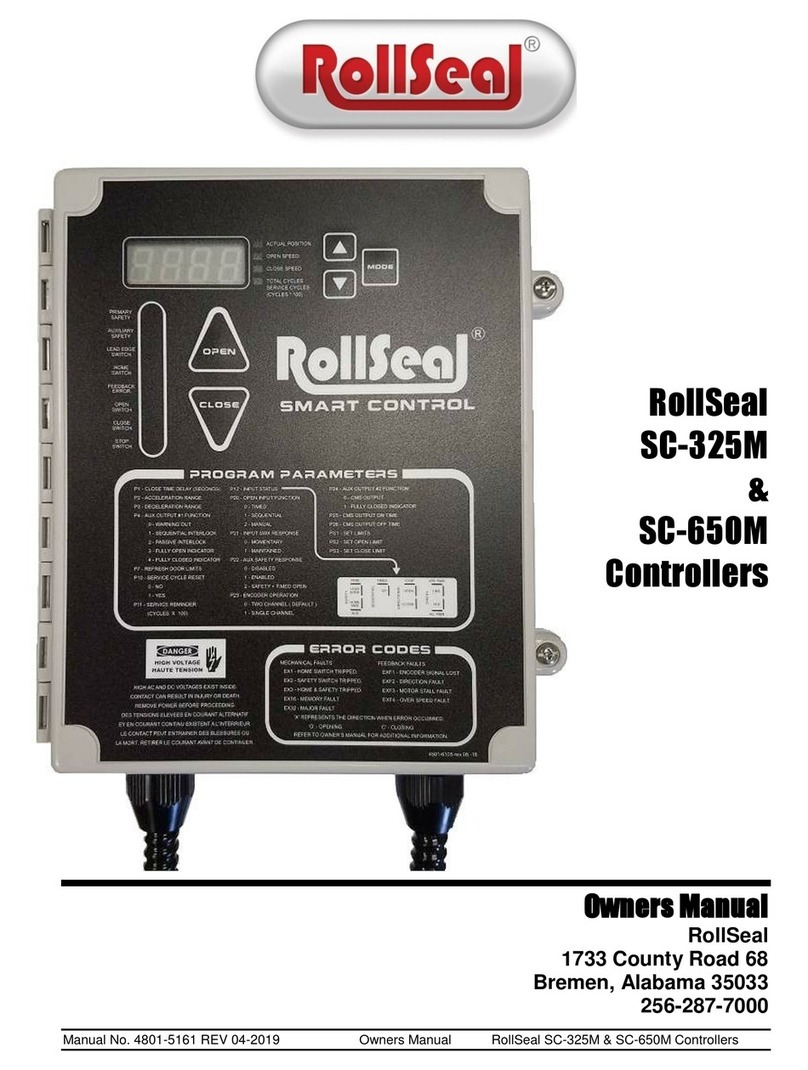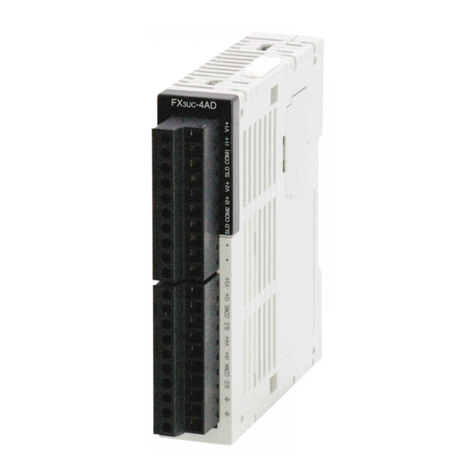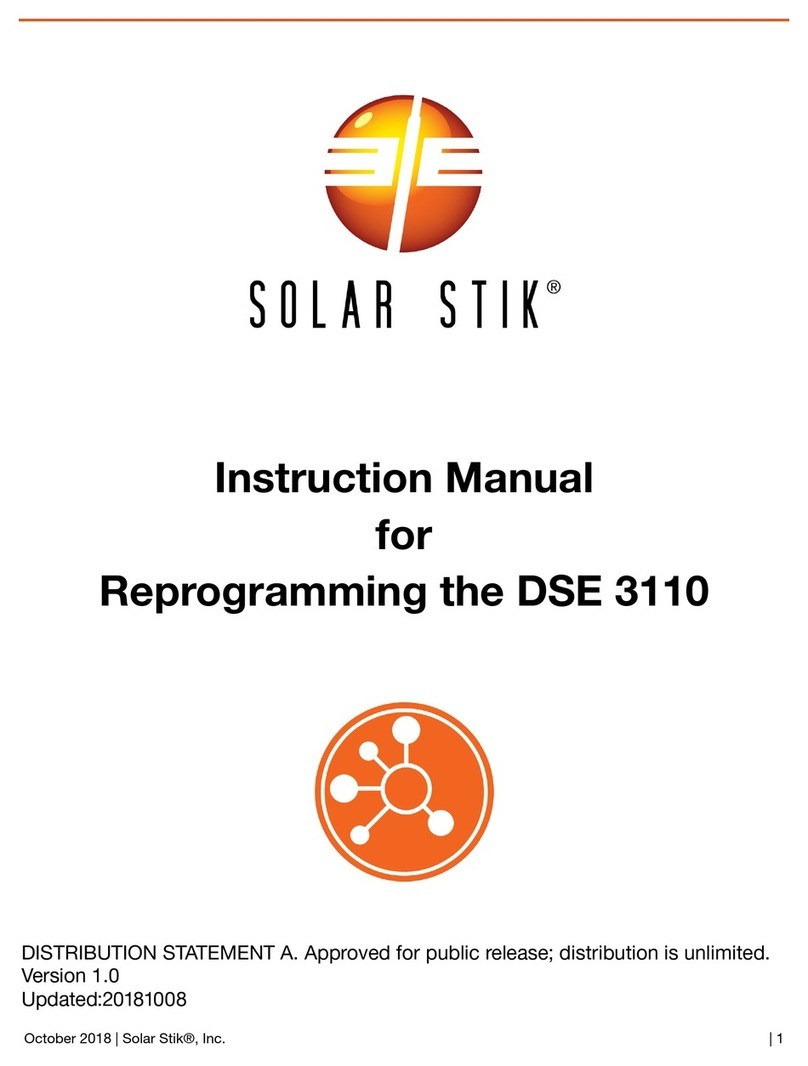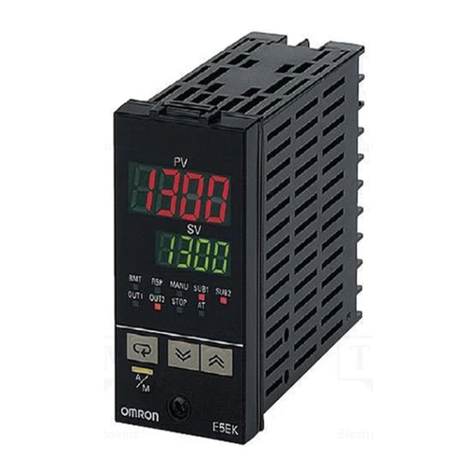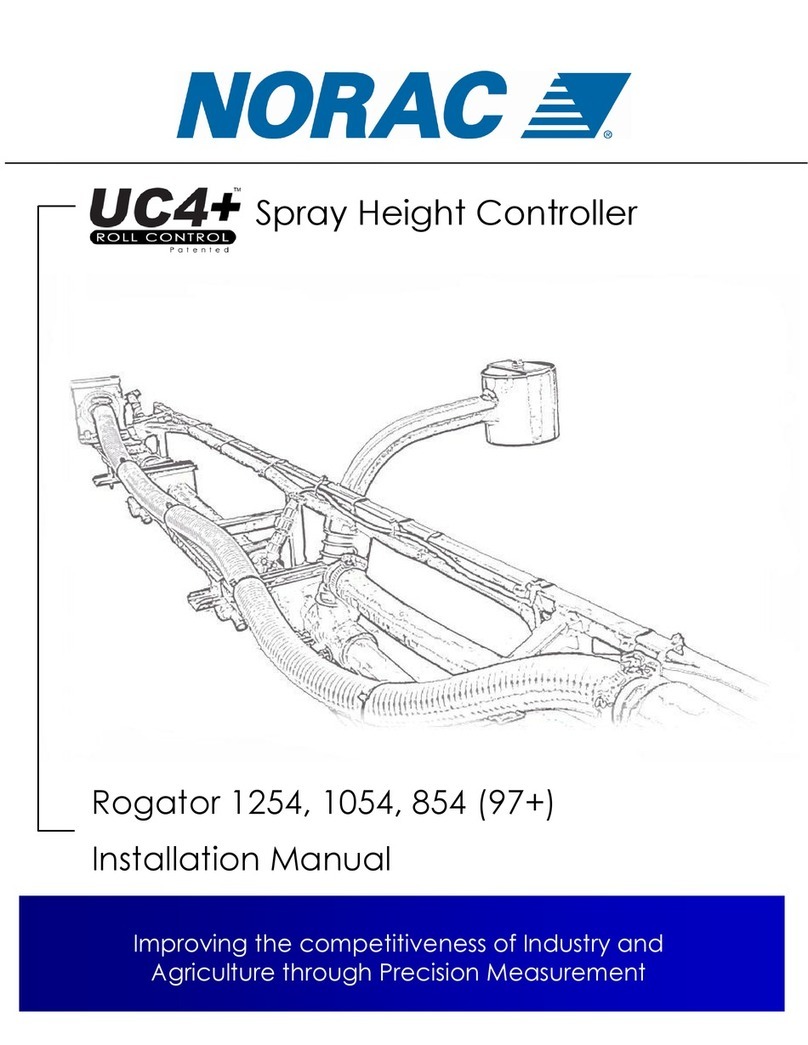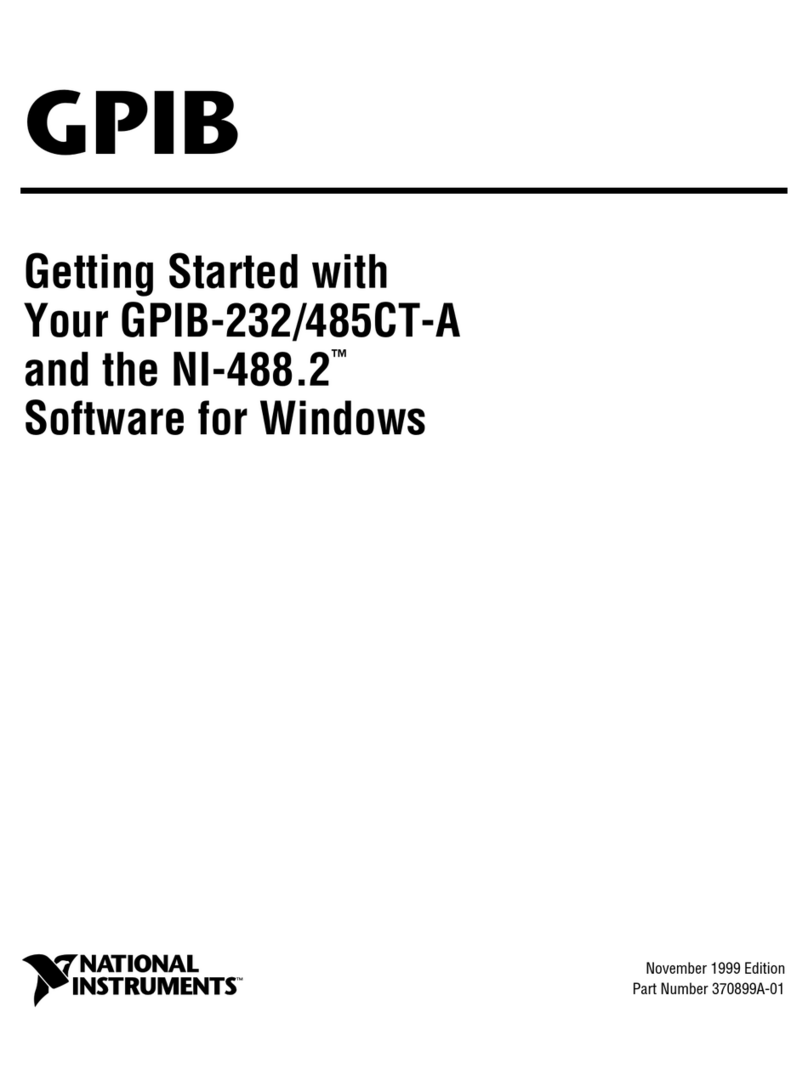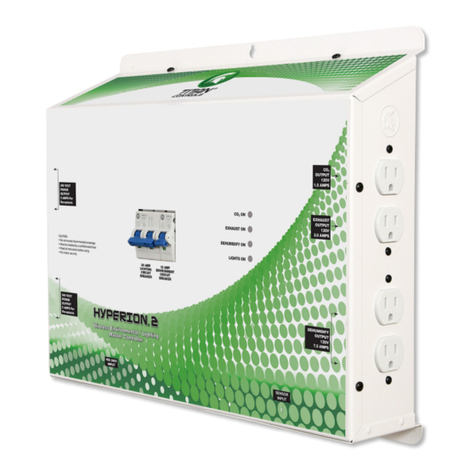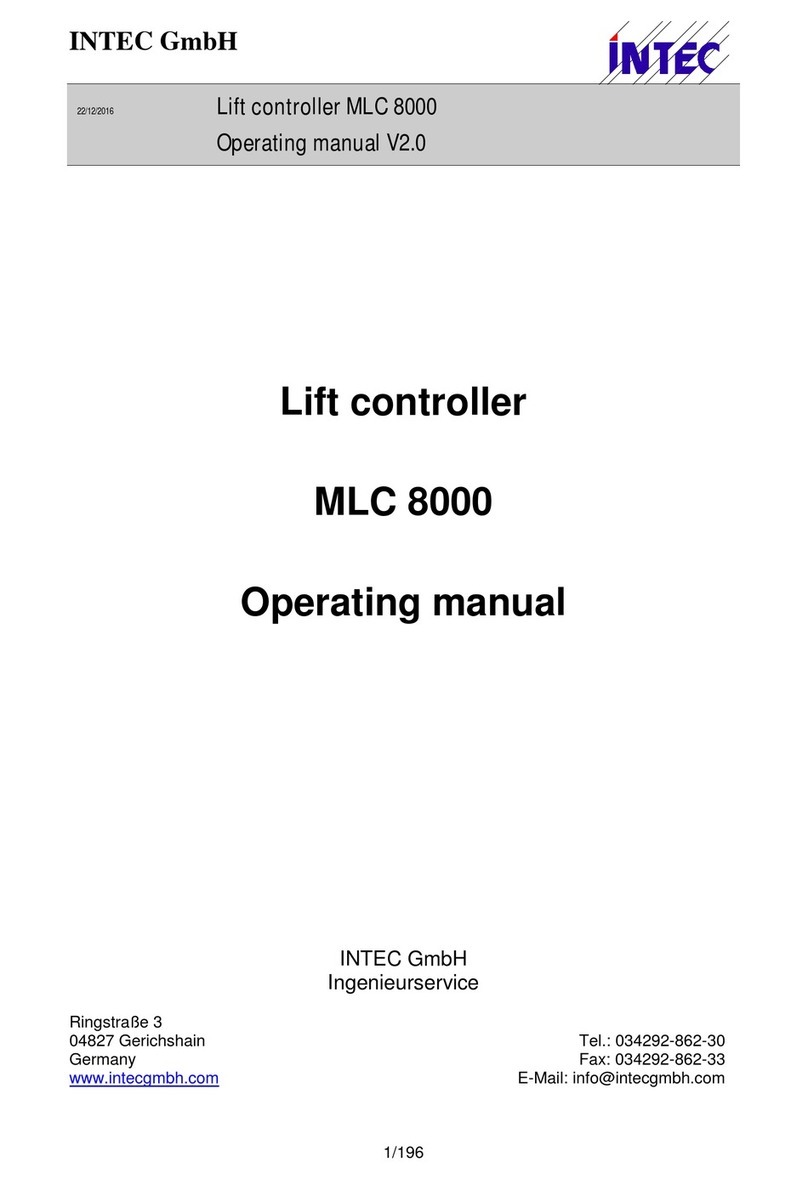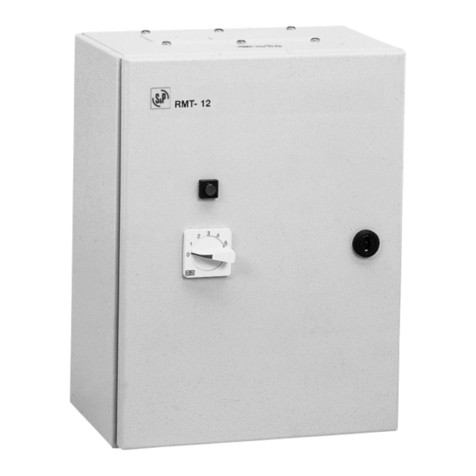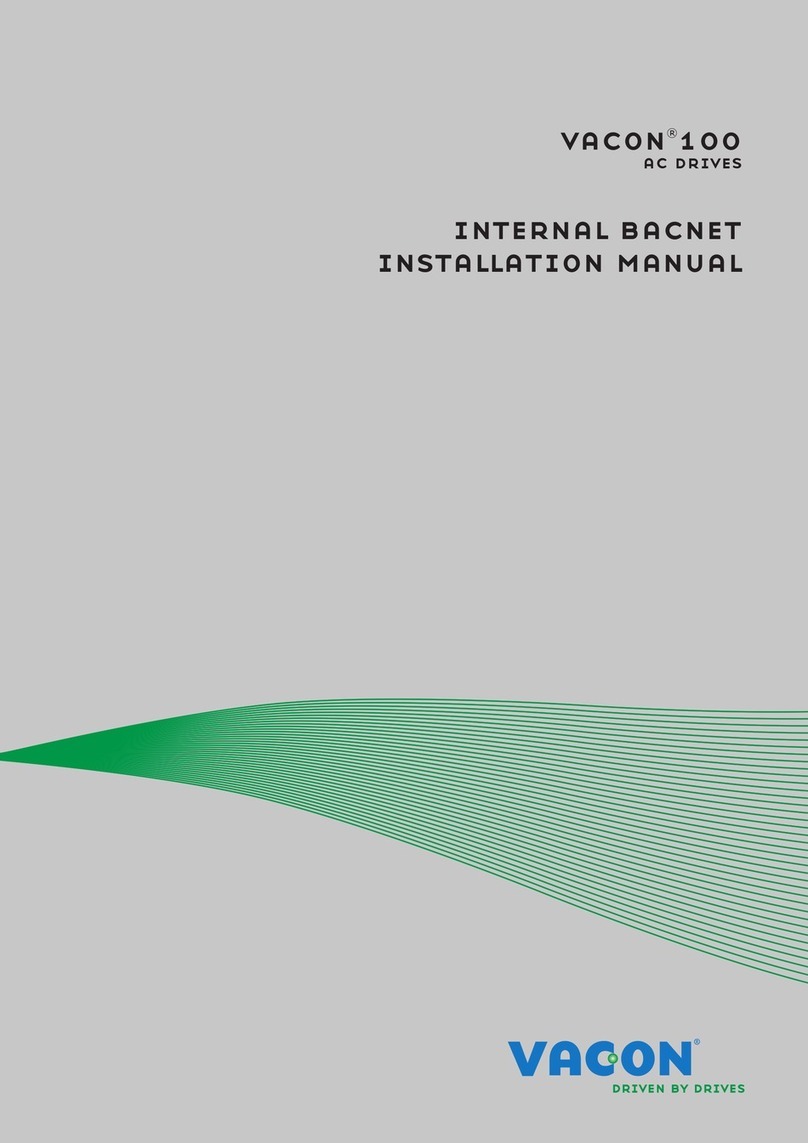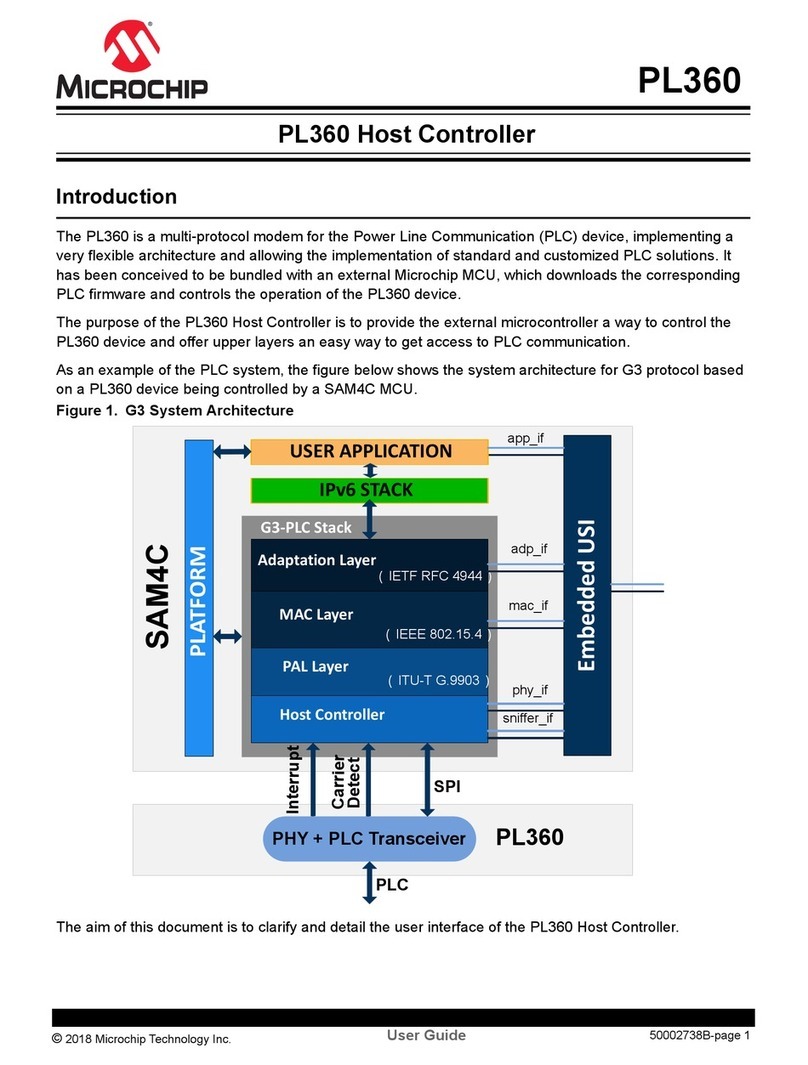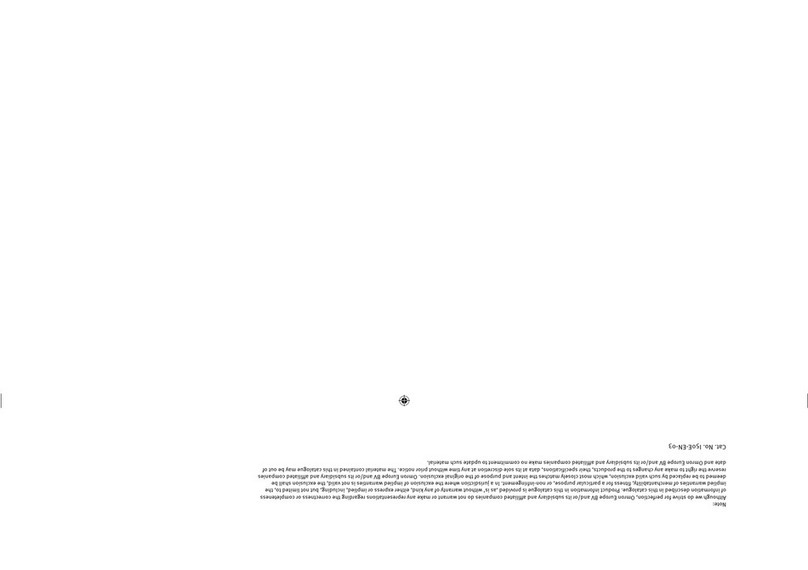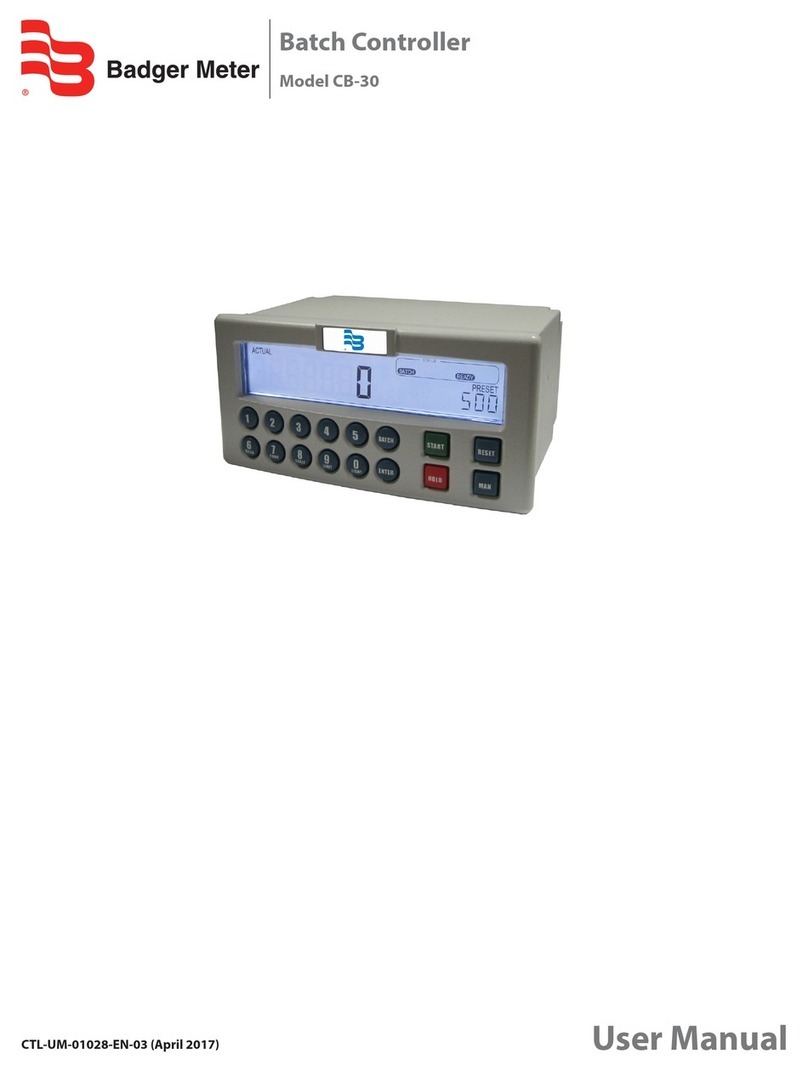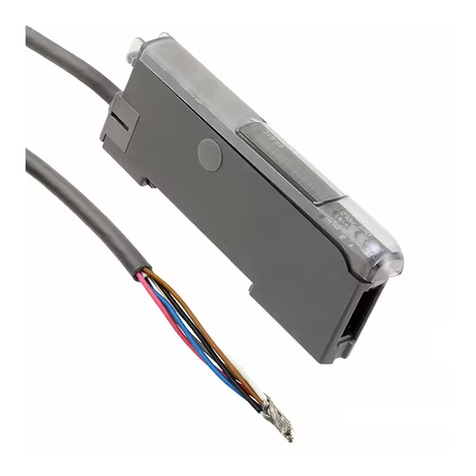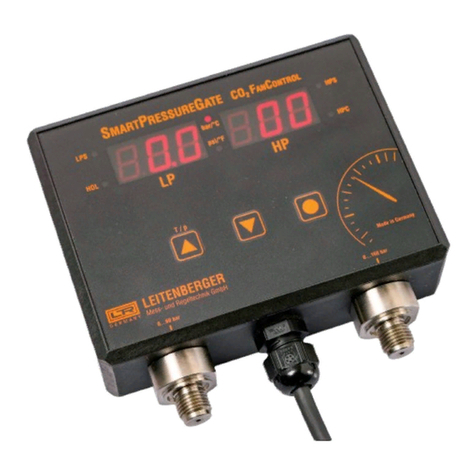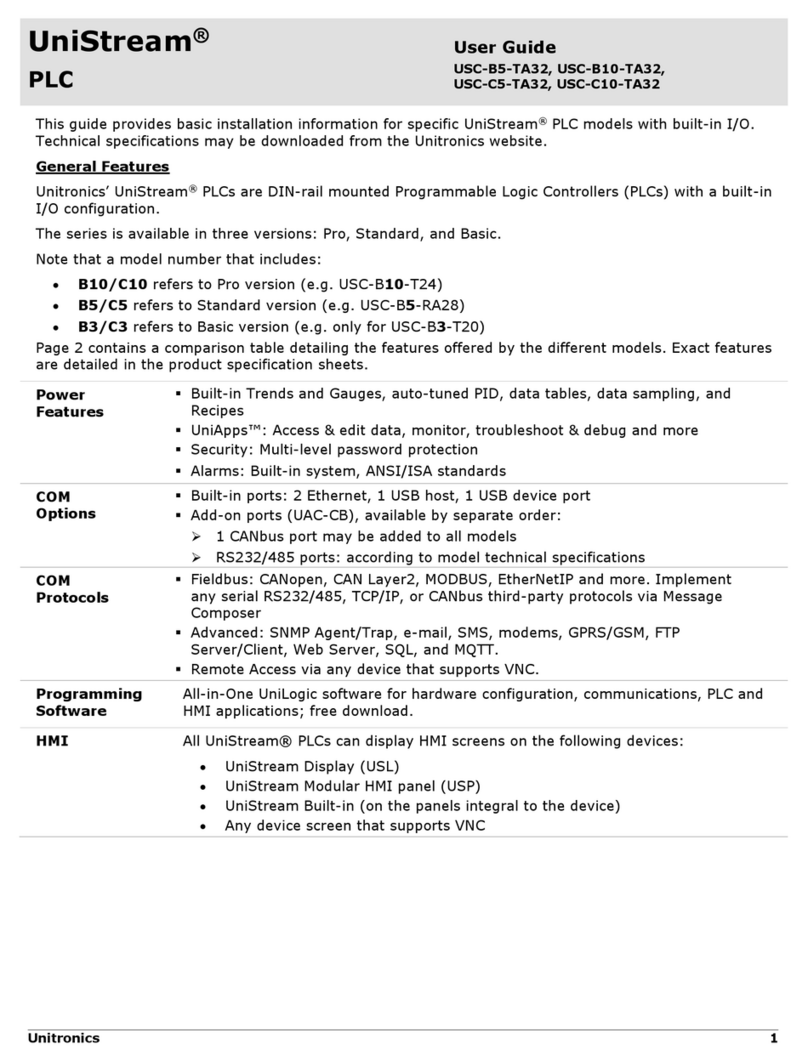RollSeal SC-325-V01-0 User manual

Manual No. 4801-5156 Rev 1-15 Owners Manual RollSeal SC-325 & SC-650
RollSeal SC-325 & SC-650 Controllers
Owners Manual
RollSeal
1751 Co Rd 68
PO Box 140
Bremen, AL 35033

Manual No. 4801-5156 Rev 4-08 Table of Contents RollSeal SC-325 & SC-650
Table of Contents
Section Title Page
1. Warnings (Avertissements) ............................................................................................................................3
2. Limited Warranty ...........................................................................................................................................7
3. Ratings and Specifications..............................................................................................................................8
4. Introduction ....................................................................................................................................................8
4.1 How the Smart Controllers Communicate with the RollSeal Automatic Doors.....................................9
5. Smart Controller User Interface......................................................................................................................9
5.1 The Power Switch...................................................................................................................................9
5.2 The Display Indicator ...........................................................................................................................10
5.3 Interpreting the Display Indicator.........................................................................................................10
5.4 Safety Beam..........................................................................................................................................12
5.5 Leading Edge Switch Option................................................................................................................12
5.6 Home and Safety Limit Switches .........................................................................................................12
6. SC-325 and SC-650 Initial Setup .................................................................................................................12
6.1 Program Mode ......................................................................................................................................12
6.2 Acceleration and Deceleration Range...................................................................................................15
6.3 Switch Settings .....................................................................................................................................16
6.4 Door Setup............................................................................................................................................16
7. Jog Mode ......................................................................................................................................................17
8. Door Activation Methods .............................................................................................................................17
8.1 Directional Switch Input.......................................................................................................................18
8.2 Manual (Single) Switch Input...............................................................................................................18
8.3 Timed Switch Input ..............................................................................................................................18
9. Troubleshooting Controller and/or Door......................................................................................................19
9.1 P12 – Input Status Indicators................................................................................................................19
9.2 Error Codes and Recommended Action ...............................................................................................20
10. Controller Installation and Setup..............................................................................................................21
10.1 Tools Required .....................................................................................................................................21
10.2 Installation Instructions ........................................................................................................................21
10.3 Typical Smart Controller Installation ...................................................................................................22
11. Accessories ...............................................................................................................................................23
11.1 Power BackUp for SC-325 Controller (Ordered Separately) ...............................................................23
11.2 Remote Transmitter and Receiver (Ordered Separately)......................................................................23
11.3 2-Button Close/Open Switch Module (Ordered Separately) ................................................................24
11.4 Ceiling/Wall Mount Pull Switch Assembly (Ordered Separately) .......................................................24
12. Wiring Diagrams, Schematics, etc............................................................................................................25
12.1 Smart Controller SC-325 V1 Layout....................................................................................................25
12.2 Smart Controller SC-325 V1 Connection Diagram (Internal Wiring)..................................................26
12.3 Smart Controller SC-325 V2, SC-650 V1 & V2 Layout......................................................................27
12.4 Smart Controller SC-325 V2, SC-650 V1 & V2 Connection Diagram (Internal Wiring)....................28
12.5 Connecting AC Power to the Smart Controller ....................................................................................29
12.6 RS-500/600 Motor Brake Rectifier Wiring Diagram ...........................................................................30
12.7 Connecting Power BackUp to the SC-325 Controller ..........................................................................31
12.8 Connecting to the Automatic Doors .....................................................................................................32
12.9 Interlocking Two Automatic Doors......................................................................................................33
12.10 Connecting the Operator Switches to the Smart Controller..............................................................34
12.11 Connecting Switches and Remote Receiver to the Smart Controller ...............................................35
12.12 Connecting Switches to the SC-325 Wiring Option “-W01” ...........................................................36
12.13 Connecting Moving Door Warning Light to the Smart Controller...................................................37
12.14 RollSeal Automatic Door Wiring Diagram ......................................................................................38
12.15 RollSeal Smart Controller Wiring Diagram .....................................................................................39
13. Replacement and Optional Parts...............................................................................................................40

Manual No. 4801-5156 Rev 4-08 RollSeal SC-325 & SC-650 Page 3 of 44
1. Warnings (Avertissements)
WARNING!
Disconnect All Power Sources Before Installing this Equipment. Failure to
Disconnect Power Source Can Result in Property Damage, Serious Injury or
Death!
WARNING!
The installer is responsible for complying with all relevant regulations, such as
national wiring regulations and accident prevention regulations. Particular
attention must be given to the cross-sectional areas of conductors, the selection
of fuses or other protection, and protective earth/ground connections!
WARNING!
The voltages in the power cables and certain parts of the drive can result in
death. Whenever the drive has been used it must be isolated and disconnected
for 5 minutes before any work commences.
WARNING!
Drives are intended as components for incorporation into electrical control
systems or machines. It is the responsibility of the installer to ensure that the
drive is installed safely and in accordance with any regulations which apply to the
end product at the place of use, for example regarding safety or electromagnetic
compatibility. To ensure mechanical safety, additional safety devices such as
electro-mechanical interlocks may be required!
DANGER!
Only qualified electrical personnel familiar with the construction and operation of
this equipment and the hazards involved should install, adjust, and/or service this
equipment. Read and understand this manual in its entirety before proceeding.
Failure to observe this precaution could result in severe bodily injury or loss of
life.
!
!
!
!
!

Manual No. 4801-5156 Rev 4-08 RollSeal SC-325 & SC-650 Page 4 of 44
IMPORTANT INSTALLATION INSTRUCTIONS
WARNING!
To reduce the risk of severe injury or death:
1. READ AND FOLLOW ALL INSTALLATION INSTRUCTIONS.
2. Do not connect the door operator to the source of power until instructed to
do so.
3. Locate the control station: (a) within sight of the door, (b) at a minimum
height of 5 feet so small children cannot reach it, and (c) away from all
moving parts of the door.
4. For products having a manual release, instruct the end user on the
operation of the manual release.
IMPORTANT SAFETY INSTRUCTIONS
WARNING!
To reduce the risk of severe injury or death:
1. READ AND FOLLOW ALL INSTRUCTIONS!
2. Never let children operate or play with door controls. Keep the remote
control (where provided) away from children.
3. Personnel should keep away a door in motion and keep the moving door
in sight until it is completely closed or opened. NO ONE SHOULD
CROSS THE PATH OF A MOVING DOOR.
4. Test the door’s safety features at least once a month. After adjusting
either the speed or the limit of travel, retest the door operator’s safety
features. Failure to adjust the operator properly may cause severe injury
or death.
5. For products having a manual release, if possible, use the manual release
only when the door is closed. Use caution when using this release when
the door is open.
6. KEEP DOORS PROPERLY OPERATING AND BALANCED. See Door
Manufacturer’s Owner’s Manual. An improperly operating or balanced
door can cause severe injury or death. Have trained door systems
technician make repairs to cables, spring assemblies, and other hardware.
7. SAVE THESE INSTRUCTIONS.
!
!

Manual No. 4801-5156 Rev 4-08 RollSeal SC-325 & SC-650 Page 5 of 44
French Translated Warnings
AVERTISSEMENT!
Disjoindre fournissent de l'énergie tout les sources avant qu'installer cet équipement.
Manque à disjoindre la source de pouvoir peut résulter dans dommage de propriété,
blessure sérieuse ou mort !
AVERTISSEMENT!
L'installer est responsable pour conformer avec tout règlement pertinent, telles que
règlement et règlement de prévention d'accident de montage sur fil de fer nationaux.
L'attention particulière doit être donnée pour les aires sectionnelles transversales de
conducteurs, le choix d'elles fusées ou autre protection, et terre / prises de terre protecteur
!
AVERTISSEMENT!
Les tensions dans le pouvoir câblent et certains parties de la promenade en voiture
peuvent résulter dans la mort. Toutes les fois la promenade en voiture a été utilisée il
doit être isolé et détaché pendant 5 minutes avant que tout travail commence.
AVERTISSEMENT!
Les promenades en voiture sont projetées comme composants pour l'incorporation dans
les systèmes ou machines d'autorité électriques. Il est la responsabilité de l'installer pour
assurer que la promenade en voiture est installé sans risque et selon tout règlement qui
appliquer pour le produit fini au lieu d'utilisation, par exemple concernant sécurité ou la
compatibilité électromagnétique. Pour assurer que sécurité mécanique, les dispositif de
sécurité supplémentaires telle que de |electro| mécanique enclenche pouvoir être exigé!
DANGER!
Seulement familier électrique de personnel qualifié avec la construction et opération de
cet équipement et les hasards ont enveloppé devoir installer, arranger, et/ou - la révision
cet équipement. Lu et comprendre ce manuel en entier avant que procéder. Manque à
observer cette précaution peut résulter dans dommage corporel sévère ou perte de vie.
!
!
!
!
!

Manual No. 4801-5156 Rev 4-08 RollSeal SC-325 & SC-650 Page 6 of 44
LES INSTRUCTIONS D'INSTALLATION
IMPORTANTES
AVERTISSEMENT!
À réduire le risque de blessure sévère ou mort:
1. LU ET SUIVENT TOUTES INSTRUCTIONS D'INSTALLATION.
2. Ne liez pas l'opérateur de porte per la source de pouvoir jusqu'à instruit faire
ainsi.
3. Localisez la station de commande: (a) en vue de la porte, (b) à un minimum la
hauteur de 5 pieds ainsi petit enfants ne peuvent pas l'atteindre, et (c) loin de
tous parties en mouvement de la porte.
4. Pour produits ayant un délivrance manuelle, instruire l'utilisateur final sur
l'opération de la délivrance manuelle.
RÈGLEMENTS DE SÉCURITÉ IMPORTANTS
AVERTISSEMENT!
À réduire le risque de blessure sévère ou mort:
1. LU ET SUIVENT TOUTES INSTRUCTIONS!
2. Jamais laisser fonctionner enfants ou mouvoir vivement avec les autorités de porte.
Gardez la télécommande (où a fourni) loin des enfants.
3. Le personnel devrait garder loin une porte dans mouvement et subsistance la porte
en mouvement dans vue jusqu'à est complètement fermé ou avoir ouvert. CES
AUCUNS DOIVENT CROISER LE CHEMIN D'UNE PORTE EN MOUVEMENT.
4. Éprouvez les traits de sécurité de la porte au moins une fois par mois. Après
qu'arrangeant la vitesse ou la fin de course, retest les traits de sécurité de
l'opérateur de porte. Manque à arranger l'opérateur correctement peut causer
blessure sévère ou mort.
5. Pour produits ai manuel la délivrance, si possible, utiliser la délivrance manuelle
seulement quand la porte est fermée. Précaution d'utilisation à utiliser cette
délivrance quand la porte est ouverte.
6. GARDER LES PORTES CORRECTEMENT QUI OPÈRE ET ÉQUILIBRÉ. Voir la
porte fabricant propriétaire manuel. Un improprement qui opère ou balancé porte
peut causer blessure sévère ou mort. Formez les technicien de systèmes de porte
faitez les réparations per les câbles, réunions de source, et autre quincaillerie.
7. SAUVEZ CES INSTRUCTIONS.
!
!

Manual No. 4801-5156 Rev 4-08 RollSeal SC-325 & SC-650 Page 7 of 44
2. Limited Warranty
All products are warranted to be free from defects in material and workmanship for a period of
one (1) year or 100,000 cycles, whichever occurs first, from the date of purchase if installed and
used in strict accordance with the installation instructions. Liability is limited to the sale price of
any products proved to be defective or, at manufacturer’s option, to the replacement of such
products upon their return. No products are to be returned to the manufacturer, until there is an
inspection and/or a return-goods authorization (RGA) number is issued.
All complaints should be directed first to the authorized distributor who sold the product. If
satisfaction is not obtained or the name of the distributor is not known, write the manufacturer
that appears below, directed to the attention of Customer Service Manager.
This limited warranty is expressly in lieu of any and all representations and warranties expressed
or implied, including any implied warranty of merchantability or fitness for a particular purpose.
The remedy set forth in this limited warranty shall be the exclusive remedy available to any
person. No person has authority to bind the manufacturer to any representation or warranty other
than this limited warranty. The manufacturer shall not be liable for any consequential damages
resulting from the use of our products or caused by any defect, failure or malfunction of our
products. (Some areas do not allow the exclusion or limitation of incidental or consequential
damages, so the above limitation or exclusion may not apply to you.)
This warranty gives you specific legal rights and you may also have other rights that vary from
area to area.
Warrantor:
RollSeal
PO Box 140
1751 County Road 68
Bremen, AL 35033

Manual No. 4801-5156 Rev 4-08 RollSeal SC-325 & SC-650 Page 8 of 44
3. Ratings and Specifications
Part Number 6607-8055 6607-8056 6607-8058 6607-8100 6607-8101
Model Number SC-325-V01-0 SC-325-V02-0 SC-325-V01-000-W01 SC-650-V01-0 SC-650-V02-0
Power Supply 115 VAC or 230 VAC 50/60 Hz Single Phase
Temperature
Range 32°F - 115°F (0°C – 46°C)
Inputs 10 Amps @ 120 VAC Single Phase
or 6 Amps @ 240 VAC Single Phase 12 Amps @ 120 VAC Single Ph.
or 8 Amps @ 240 VAC Single Ph.
Outputs 240 VAC Three Phase ¼ h.p. 240 VAC Three Phase ½ h.p.
Drive Setting Version 01 Version 02 Version 01 Version 01 Version 02
Factory Preset
Voltage Switch
& Jumper
115 VAC 115 VAC 115 VAC 230 VAC 230 VAC
Power Cord N/A N/A N/A N/A N/A
Switch &
Warning Wires
with Conduit
N/A N/A -W01 Switch
Wiring Option N/A N/A
4. Introduction
The RollSeal SC-325 & SC-650 Smart Controllers are intelligent controllers manufactured specifically for
the RollSeal RS-500 and RS-600 Automatic Doors. The Smart Controllers will provide safe opening and
closing of the door by using a number of internal safety devices plus those features provided in the
components of the automatic doors. The Smart Controllers can control the opening and closing speeds of
the door, count the number of door operations, and provide status information for remote monitoring of the
door position. In addition, the Smart Controllers can combine a number of auxiliary devices to improve the
operability of the automatic doors such as:
(1) Remote radio controlled inputs for operating the door.
(2) Infrared sensors to detect the presence of personnel or machinery requiring passage through
the door.
(3) Auxiliary lights or alarms that operate in conjunction with door opening or closing.
The Smart Controllers are very versatile and simple to operate. The controls are easily operated from the
front panel.
SC-650 Controller
Powe
r
Switch
Displa
y
Indicato
r
Main Fuse
SC-325 Controller

Manual No. 4801-5156 Rev 4-08 RollSeal SC-325 & SC-650 Page 9 of 44
WARNING: DO NOT Turn The Power ON Until All Of The Following Items Are Completed:
All Wire And Cable Connections Are Completed.
The Voltage Selection Switch And Jumper Are Set To Match The Required Supply Voltage.
The Motor Brake Rectifier Is Wired Accordingly To Match The Required Supply Voltage.
4.1 How the Smart Controllers Communicate with the RollSeal Automatic
Doors.
Inside the upper right housing of the RollSeal automatic doors is an encoder that sends electrical
pulses to the Smart Controllers when the door is moving and the controller is in the normal
operating mode. (See Section 12.14 for wiring diagram of the encoder). The controllers refer to
the position of the door in units of “Counts”, which is based upon the number of encoded pulses
that the encoder sends to the controller.
A Count of zero is assigned to the full open position where the Home switch operates, and the
highest count is assigned to the full closed position. The maximum number of counts that the
controller will read will depend upon the particular installation. In general, a count is
approximately equal to 1/8 inch of door movement. Several of the parameters of the controller are
displayed in units of Counts, such as the Actual Position, the Open and Closed Limit Positions
and the Acceleration and Deceleration Ranges.
5. Smart Controller User Interface
5.1 The Power Switch
The Power Switch of the Smart Controller is located on the left side of the controller box as
illustrated on the previous page. The switch controls power to the Smart Controllers and to the
automatic doors. The Main Fuse is located on the outside, bottom-left of the enclosure.
Refer to Section 6.3 for Switch Settings information. Refer to Section 12.1 (for V1) or 12.3 (for
V2) and 12.5 for the location of SWX2 on PCB 154 and J1 on the Motor Drive board assembly.
Refer to Section 12.6 for specific RS-500/600 Motor Brake Rectifier wiring diagrams.
NOTE: The term Position Units is used throughout this document and refers to
the position of the door in units of Counts.
SC-325 & SC-650 Controller Dimensions

Manual No. 4801-5156 Rev 4-08 RollSeal SC-325 & SC-650 Page 10 of 44
5.2 The Display Indicator
The Display Indicator
can show four different
types of readings that
can be selected by
pressing the Mode
button on the Display.
Each time the Mode
button is depressed the
display steps to the next
parameter as indicated
by the green LED next to the display.
The four readings on the Display Indicator selected by using the Mode button are:
Actual Position – The position of the door curtain in relative position units called Counts. See
Section 4.1 for a description of Counts. A low Count reading indicates that the
door is at the top or open position. The highest Count reading is when the door
is at the bottom or closed position.
Open Speed – The percentage of full speed that the door will open. The full speed will depend
on the type of drive motor installed. This can be changed from a low of 20
percent to a high of 100 percent.
Close Speed – The percentage of full speed that the door will close. The full speed will depend
on the type of drive motor installed. This can be changed from a low of 20
percent to a high of 75 percent.
Total Cycles – The total number of times (cycles) that the door has been opened and closed.
The value displayed is in units of 100 cycles. For example a reading of 20
means that the door has been operated between 2000 and 2099 times.
Service Cycles – The number of times (cycles) that the door has been opened and closed since the
last service reset. The value displayed is in units of 100 cycles. For example, a
reading of 20 represents between 2000-2999 cycles. This cycle count is used
for service purposes. Refer to Section 6.1 for information on how to reset this
count and how to set Service Reminders.
To view each of the four parameters, press the Mode button repeatedly until the green LED on the
Display Indicator shows the desired parameter to be read or changed. Use the Up/Down arrows to
adjust the Speed percentage to the desired setting. To read the number of times the door has been
cycled, press the Mode button until the green LED beside Cycles (x100) is lighted. To return to
the Actual Position, press the Mode button again, or wait a few seconds and the controller will
automatically return to displaying Actual Position.
There is an LED on the Display Indicator that will light when the Safety beam is interrupted. See
Section 5.4 for more discussion on the function of the Safety Beam.
5.3 Interpreting the Display Indicator
In addition to the readings that can be selected by using the Mode button, the Smart Controller
will occasionally display other readings on the Display Indicator that can show the operating
status of the controller. This section describes some other types of displays that will occur in the
normal operation of the controllers.
2
4
0.
Safety Beam Obstructed
Mode Button
Up/Down Arrows

Manual No. 4801-5156 Rev 4-08 RollSeal SC-325 & SC-650 Page 11 of 44
SOFTWARE VERSION AND MODEL NUMBER
When the Smart Controller is turned
off and subsequently on again, the
Display Indicator will flash the
current software version and model
number in the display. This will
remain on the display about two
seconds. Then the display will show
the Actual Position of the door.
ACTUAL POSITION READING
When displaying the actual position
of the door, the Display Indicator will
appear similar to the diagram on the
right. In the example shown, the
door is in a position of 240 counts.
UNKNOWN POSITION INDICATION
There are occasions when the
controller may not know the exact
position of the door, for example,
when returning from the Jog
Mode. In these cases the Display
Indicator will display a series of
three bars as shown at the right.
This is known as the Unknown
Position Indication.
When the door is actuated, the door will proceed to the full open position, however the
speed of the door will be reduced. When the door has returned from the home switch
position to the open limit position, the display will show the actual position of the door.
This indicates that the door has reset its position and is ready for normal operation.
ASSUMED POSITION INDICATION
When the controller is first turned on, the display will flash between a numerical actual
position reading and the unknown position indication. This flashing indicates the controller
has assumed the current position of the door. When the control button is pressed, the
controller will open at full speed to the open limit of the door. Then the door will proceed
to the Home switch to verify the position reading and return to the open limit position.
This operation takes place to verify that the door was not manually adjusted during the time
that power was removed from the controller.
JOG MODE INDICATION
When the Smart Controller is in the
Jog Mode, the display will indicate
“J O G” as shown at the right. See
Section 7 for a description of the
Jog Mode.
J O
G
Jog Mode
-- --
Unknown Position Indication
2 4
Actual Position Reading
S8#
Software Version Number
Model Number
8 = SC-325 Model
9 = SC-650 Model

Manual No. 4801-5156 Rev 4-08 RollSeal SC-325 & SC-650 Page 12 of 44
2 4 0
Flashing
Service
Cycles LED
2 4 0
.
Door Obstruction
Light
SERVICE REMINDER INDICATION
When the Smart Controller has
exceeded the selected Service Cycle
Limit, the Service Cycles LED will
begin flashing to indicate that
service is needed. See Section 6.1
P10 and P11 for a description of the
Service Cycle Reset and Service
Reminder.
5.4 Safety Beam
The Smart Controller uses an invisible safety
beam near the bottom of the automatic doors
to prevent the door from closing on an object
that has moved into position under the door.
If an object interrupts this beam of invisible
light, the door will stop and the Door
Obstruction Light in the controller display
will light. The door may then proceed to
open depending on the setting of switch
SWX1. If SWX1:1 is “On”, the door will
proceed to open to its full open position. If SWX1:1 is “Off”, the door will stop and await a
command to either continue opening or to close. See Section 12.1 for the location of SWX1 on
the controller PCB 154 circuit board.
5.5 Leading Edge Switch Option
The door may be equipped with an optional Leading Edge Switch. This switch works in
conjunction with the safety beam. Its function is to provide a back-up for the safety beam. If
anything comes in contact with the leading edge of the panel, the door will react in the same
manner as the safety beam.
5.6 Home and Safety Limit Switches
HOME SWITCH
The RollSeal automatic doors contains a Home limit switch for determining the “Home” or
full open position of the door. When the door is fully opened the Home limit switch is
triggered to stop the door. At this position the actual reading on the Display indicator will
be zero (0). The Smart Controllers also use the operation of the Home switch to verify the
position of the door.
SAFETY SWITCH
An additional safety feature of the automatic doors is a Safety switch which will stop the
door if the Home limit switch does not stop the door at its full open position. The Safety
switch is an emergency override. Once the door has made contact with the Safety switch,
the motor’s drive unit is completely disabled. At this point the door must be manually reset
to return to normal operation. In most cases this can be done by manually releasing the
brake on the motor. This will allow the door to drift below the Safety switch.
6. SC-325 and SC-650 Initial Setup
6.1 Program Mode
Settings that are usually set up when the Smart Controller is installed or adjusted are referred to as
Program Parameters. To get to the Program Mode, press and hold the Mode button for at least
five seconds. When the controller has entered the Program Mode, the display will flash between
P1 and the current value of the program parameter. All the program parameters have a program
number assigned to them. When in the Program Mode, the current displayed parameter can be

Manual No. 4801-5156 Rev 4-08 RollSeal SC-325 & SC-650 Page 13 of 44
changed by pressing the Up ()or Down () arrows. When the current parameter has been set,
press the Mode button to move to the next parameter. The Program parameters are:
PROGRAM PARAMETERS
P1 - Close Time Delay (Seconds)
P2 - Acceleration Range
P3 - Deceleration Range
P4 - Door Interlock
0 - OFF
1 - Sequential Interlock
2 - Passive Interlock
3 - Freezer Mode - No Interlock
P5 – Auxiliary On Time
P6 – Auxiliary Off Time
P7 - Refresh Door Limits
P10 - Service Cycle Reset
0 - No
1 - Yes
P11 - Service Reminder (Cycles x 100)
P12 -Input Status
PS1 - Set Limits?
PS2 - Set Open Limit
PS3 - Set Close Limit
P1 – Close Time Delay
This is the time that the controller waits before automatically closing the door. Close Time Delay
only applies when the door has been opened using the Timed Input. All safety sensors must be
cleared before the controller begins counting the Close Time Delay. To change the value of P1, Press
the Up ( ) arrow to increase the delay and the Down ( ) arrow to decrease the delay. The Close
Time Delay can be adjusted between 5 and 240 seconds.
P2 – Acceleration Range
This is the range in counts over which the door will accelerate from a stopped position to the
maximum opening or closing speed. Refer to Section 6.2 for a detailed explanation.
P3 – Deceleration Range
This is the range in counts over which the door will decelerate from full speed to a stopped position
in either the closed or open position. . Refer to Section 6.2 for a detailed explanation.
P4- Two Door Interlock or Freezer Modes
The P4 setting is used to interlock two doors together when wired properly (See Wiring Diagram
Section 12.9) or to operate freezer equipment such as blowers or heaters. There are two different
interlock modes and one freezer mode which are explained below.
The interlock mode 1 or 2 features only apply when the doors are actuated through the “Timed” input
signal. Operation using the “Directional” switch inputs will override any interlock functions. It is
important to note that setting this parameter to 1 or 2 will reconfigure the “Manual” input and the
“Warning” output for interlock operation. Therefore using Interlock Modes 1 or 2, the switches will
not be able to be used for their normal purposes as described in Section 8.
Setting this parameter to 3 will reconfigure the “Warning” output for Freezer Mode operation.
The following explains the operation of each setting:
0 = Interlock Disabled
No Interlock features will be used. The “Manual” input and “Warning” output operate as explained
in Section 8.
1 = Sequential Interlock
The two interlock doors will work in sequence with one another. i.e. The “Timed” signal is received
by Door One. Door One opens and insures that Door Two remains closed. Once Door One’s timer
expires, Door 1 closes. Once fully closed, Door Two opens and insures that Door one remains
closed. Once Door Two’s timer expires, Door Two closes and the cycle is complete.
NOTE: Either door can initiate the cycle allowing for two-way traffic.
2 = Passive Interlock
Only one of the two doors will be allowed to be open at once.
3 = Freezer Mode – No Interlock
When the door and Smart Controller are used in freezer applications and P4 is set to 3, the Auxiliary
Output Relay is used to operate equipment such as blowers or heaters. *Available on Software
versions V0.21 and later.
Operation of the blowers or heaters will occur ONLY while the door is closed. Closed refers
to the normal operation while the door is below Safety Beam Height.

Manual No. 4801-5156 Rev 4-08 RollSeal SC-325 & SC-650 Page 14 of 44
IF P4 = 3 (Freezer Mode):
Auxiliary Output Relay will disengage during door movement, setup operation, jog mode,
etc.
Auxiliary Output Relay will engage upon the door stopping below Safety Beam Height.
If the Home Switch is engaged, the Auxiliary Output Relay will turn Off-disengage.
If the door status indicates unknown position, the Auxiliary Output Relay will turn Off-
disengage.
P5- “Freezer Mode” Auxiliary ON Time
If P4 = 3, this setting, along with P6, allows the user to cycle the fan & heater On & Off. Since not
all applications are the same, some will not require as much help eliminating condensation while
others may require more. This setting, along with P6, allows the user to operate the unit as efficient
as possible.
P6- “Freezer Mode” Auxiliary OFF Time
This setting works in conjunction with P5 to complete the On/Off cycle of the condensation removal
system.
WARNING!
When P4 Is Set To 1 or 2, The Functions Of The “Manual” Input Or The “Warning” Output Are
Reconfigured For Interlock Operation And Can Not Be Used For Their Normal Functions.
When P4 Is Set To 3, The Functions Of The “Warning” Output Are Reconfigured For Freezer
Operation And Can Not Be Used For Their Normal Functions.
P7 – Refresh Door Limits
This parameter is associated with the Open and Close Limits programmed into the door. These limits
are determined using an encoder and they are referenced off of the “Home Switch” located in the
door header. From time to time, the Open and/or Close Limits may drift due to the nature of the
encoder. This setting allows the user to set a number of Open & Close cycles before the door
refreshes its limits by going back to its Home reference. This value can be set from 1 to 25. One
means it will refresh every time it opens; Twenty-five means it will refresh every 25th time it opens.
P10 – Service Cycle Reset
This parameter provides a means for a service technician to reset the Service Cycle Count. This
provides a means to track cycles in an effort to properly maintain the door system. If you desire to
reset the Service Cycle Count, you must change P10 from “NO” to “YES” by pressing the Up ( )
arrow button. To complete the reset, you must then depress the “MODE” button.
P11 – Service Reminder
This parameter works in conjunction with P10 to provide a means for the controller to visually
remind the service technician when it is time for service. The user can set a Service Cycle Limit in
this parameter. The limit (displayed number from 10 to 240) shown is “Cycles x 100” just as the
cycle counts are displayed. This parameter is constantly compared to the value in “Service Cycles”.
Once the “Service Cycles” is greater than or equal to “Service Reminder”, the “Cycle LED” on the
controller interface will begin blinking indicating that service is needed. EXAMPLE: If the P11
displayed value is 10, the “Cycle LED” on the controller interface will begin blinking after the door
has operated 1000 cycles.
P12 – Input Status
This parameter is used only to service or troubleshoot the door. The various inputs are represented
by LED segments on the display. *Available on Software versions V0.21 and later.
Refer to Section 9.
PS1 – Change Program Limits
This parameter can be either “Yes” or “No”. To change the Open Limit (PS2) or the Closed Limit
(PS3) set this parameter to “Yes” and then proceed by pressing the Mode button. To leave the
!

Manual No. 4801-5156 Rev 4-08 RollSeal SC-325 & SC-650 Page 15 of 44
programming mode at this time, set PS1 to “No” and press the Mode button. The controller will exit
the programming mode and return to displaying the actual position.
PS2 – Set Open Limit
When the Mode button is pressed after setting PS1, the door will open to the position of the Home
switch then proceed toward the current setting of the Open Limit. Use the Up and Down arrows to
set the door to a new Open Limit position. Then press Mode to proceed to the next parameter.
PS3 – Set Closed Limit
When the Mode button is pressed after setting the Open Limit, the door will close to the current
setting of the Closed Limit. Use the Up ( ) and Down ( ) arrows to set the door to a new Closed
Limit position. Then press Mode to exit the programming mode and return to displaying the actual
position.
6.2 Acceleration and Deceleration Range
The Smart Controllers measure the position of the door in Relative Position Units called counts.
(See Section 4.1.) Counts are read from the door encoder and transmitted to the controller as
electrical pulses. Counts begin at zero when the door is open and get higher as the door is closed.
Acceleration and Deceleration ranges are also measured in Counts.
The Smart Controllers have programmable adjustments for the Acceleration and for the
Deceleration Ranges. These are adjusted by setting the program parameters P2 and P3. See
Section 6.1 for the procedure to set these parameters.
The acceleration range is measured in units of counts and is the range over which the door will
accelerate from a stopped position to the open or close speed. The Deceleration Range is
measured in units of counts and is the range over which the door will decelerate from the open or
close speed to a stopped position. Typical values for the Acceleration Range are 40 counts and
for the Deceleration Range is 80 counts.
These ranges are illustrated in the shown graph for the case of opening the door. From the full
closed position, the door accelerates to the open speed during the Acceleration Range then slows
during the Deceleration Range to the open position.
P2 AND P3 SETTINGS THAT PRODUCE A “SMOOTH” DOOR OPERATION
The Smart Controller Acceleration and Deceleration ranges (P2 and P3) should be
adjusted to produce a smooth acceleration and minimize the use of the motor brake when
stopping. The following table shows approximate values for parameters P2 and P3 that
will produce a smooth and efficient door operation based upon the speed of the door.
Values of P2 & P3 for Smooth Door Operation
SPEED
(inches/sec.)
P2 Acceleration
(Counts)
P3 Deceleration
(Counts)
14 20 40
20 25 50
28 30 60
42 40 80

Manual No. 4801-5156 Rev 4-08 RollSeal SC-325 & SC-650 Page 16 of 44
WARNING: DO NOT Turn The Power ON Until All Of The Following Items Are Completed:
All Wire And Cable Connections Are Completed.
The Voltage Selection Switch And Jumper Are Set To Match The Required Supply Voltage.
The Motor Brake Rectifier Is Wired Accordingly To Match The Required Supply Voltage.
6.3 Switch Settings
SWX1 contains two separate switches. The first switch (SWX1:1) controls the Safety Action and
the second switch (SWX1:2) determines the Encoder Selection as follows:
PCB 154 SWX1:1 – SAFETY ACTION
Selects the operation of the door when the Safety Beam is interrupted during closing. If
at any time while the door is closing, the Safety Beam is interrupted, the door will stop.
Then if SWX1:1 is “On” the door will proceed to open to its full open position. If
SWX1:1 is “Off” the door will stop and await a command to either continue opening or
to close. See Section 12.1 for the location of SWX1 on the printed circuit board.
PCB 154 SWX1:2 – ENCODER SELECTION
Selects between the use of one encoder (SWX1:2=Off) or two encoders (SWX1:2=On)
when determining the door position. Some doors will be equipped with two encoders.
See Section 12.1 for the location of SWX1:2 on the printed circuit board.
PCB 154 SWX2 Switch and MOTOR DRIVE J1 Jumper– VOLTAGE SELECTION
The Smart Controller contains one switch and one jumper which must be set prior to
initial use and application of power. Ensure that SWX2 and J1 are both set according to
the specific required voltage. Refer to Section 12.1 (for V1) or 12.3 (for V2) and 12.5
for the location of SWX2 on PCB 154 and J1 on the Motor Drive board assembly.
The SC-325 controllers are factory preset to 115 VAC and the RS-500 doors factory
prewired to require a 115 VAC power supply. The SC-650 controllers are factory preset
to 230 VAC and the RS-600 doors factory prewired to require a 230 VAC power supply.
The SC-325/SC-650 controllers and RS-500/600 doors can be field upgraded to
accommodate either 115 VAC or 230 VAC power supply. If the desired power supply
voltage is different from the factory preset/prewired voltage, the appropriate version
Brake Rectifer must be ordered separately, field-installed on the RS Door, and the SC
controller switch & jumper settings changed accordingly. Refer to Section 12.6 for
specific RS-500/600 Motor Brake Rectifier wiring diagrams.
6.4 Door Setup
The door limits are used to adjust the door position in the full open and closed positions. To set
the door limits, use the following steps:
(1) Depress the Mode button (●) for at least 5 seconds. P1 (Close Time Delay) will be then
be displayed in the Display Indicator.
(2) Depress and release the Mode button until PS1 (Change Program Limits) is displayed.
(3) Depress Up ( ) until “yes” is displayed.
(4) Depress the Mode button again (●). PS2 (Set Open Limit) will be displayed.
(5) The door will proceed to the open limit and then stop. Once the door stops, adjust open
limit using the Up ( ) or Down ( ) buttons until open limit is satisfactory.
(6) Depress the Mode button (●) again. PS3 (Set Closed Limit) will be displayed.
(7) The door will proceed to the closed limit and then stop. Once door stops, adjust this limit
using the Up ( ) or Down ( ) buttons until the close limit is satisfactory.
(8) Depress the Mode button (●) again and the controller will exit the programming mode
and return to displaying the actual position.
(9) The setup is now complete.

Manual No. 4801-5156 Rev 4-08 RollSeal SC-325 & SC-650 Page 17 of 44
7. Jog Mode
The Jog Mode will permit an operator to manually control the position of the door with the Up ( ) and
Down ( ) arrow buttons. To enter the Jog Mode, press both the Up ( ) and Down ( ) arrows at the
same time for at least 5 seconds. The Smart Controller will indicate the Jog Mode in the display as shown
below.
In the Jog Mode the door can be opened and closed
and is not affected by the Home limit switch or the
Safety beam. Therefore, the operator must carefully
watch the door movement when nearing the full
open and full closed positions. To exit the Jog
Mode, press and hold the Up ( ) and Down ( )
arrow buttons for at least 5 seconds. The controller
will return to the normal operating mode with the
Actual Position shown in the display.
When returning to the normal operating mode, the controller will not know the exact position that the
operator has left the door when exiting the Jog mode. Therefore, the controller will display a series of
three horizontal bars. Upon the next command the door will slowly proceed to the full open position to
reset its memory. The door will always follow this procedure after exiting the Jog Mode.
8. Door Activation Methods
There are three types of operator switches that can be connected to the Smart Controllers for opening and
closing the automatic doors. These include a directional switch, a sequential switch and a timed switch.
These switches can all be connected simultaneously to the controller.
Manual
Activated Timed
Activated Open
Activated Close
Activated Stop Activated Notes
During the specific
operation below…..
TIMED Opening N/A N/A N/A N/A Stops Door after 1-2
Seconds
TIMED Closing N/A Reopens Door
& Starts Delay
N/A N/A Stops Door (Immediately)
During TIMED
Countdown Closes
Immediately
Restarts Time
Delay
Exits
Time
Delay
Closes
Door
Should Terminate Timed
Cycle
MANUAL
Opening N/A N/A N/A N/A Stops Door after 1-2
Seconds
When Stop is
pressed & door
stops, pressing the
Manual button again
will cause the door
to reverse direction
at that point.
MANUAL Closing N/A Opens then
starts Time
Delay
N/A N/A Stops Door
(Immediately)
While Completely
Open (after
MANUAL)
Closes N/A N/A Closes
Door
N/A
While OPENing N/A N/A N/A N/A Stops Door after 1-2
Seconds
While CLOSing N/A Reopens door
& starts Time
Delay
N/A N/A Stops Door (Immediately)
J O
G
Jog Mode

Manual No. 4801-5156 Rev 4-08 RollSeal SC-325 & SC-650 Page 18 of 44
Three Position
Operator Switch
8.1 Directional Switch Input
The directional switch input is primarily for use with a three
position direction switch similar to the one illustrated below.
Operation is simple. Momentarily push “OPEN” to open the door,
momentarily push “CLOSE” to close the door and momentarily
push “STOP” to stop the door. However, the SC-325 and SC-650
controller can be programmed to perform special events with these
directional switches.
For example, if the ‘STOP” button is pressed and held, the door
will remain in the stopped position. None of the other control
switches will operate as long as the “STOP” connection to the
controller is completed. Similarly, if the “OPEN” button is pressed
and held, the door will remain in the open position. And, if the
“CLOSE” button is pressed and held, the door will remain in the
closed position. These features would be useful if an operator
wanted to “lock” the door in a particular position with the use of
external switches connected in parallel with the directional switch.
For safety reasons, these directional buttons have a priority built
into the controller in case one or more of the buttons are closed at
the same time. The “STOP” switch has first priority, the “OPEN”
has second priority and the “CLOSE” has third priority.
8.2 Manual (Single) Switch Input
This switch provides a conventional means of connecting a single
button that responds to each momentary press sequentially. For
example, if the last movement of the door was in the open
direction and the manual input is made, the door will attempt to
close. Conversely, if the last movement of the door was in the
close direction and the manual input is made, the door will attempt
to open. If this single position manual switch is used with the
three position directional switch as discussed above, the manual
switch has fourth priority.
NOTE: This input will be reconfigured for use with the Interlock circuit if the P4 setting is
programmed to anything other than zero. See Setting P4 under Section 6.1 for more
information.
8.3 Timed Switch Input
The timed switch is intended for auto closure of the door and is typically used with motion
detectors, floor loops, or pull cord switches. The timed feature would be used when, for example,
a vehicle ( i.e. forklift) would open the door by means of a floor loop. Then, after the door is
opened and all safety sensors are clear, a timer would count down and close the door
automatically. In order for the timed feature to work, the door must have initially been in a closed
or stopped position. If the door was already opened by some other means, the timer would not
operate and the door would remain open.
The timed switch has priority five when the door is in the idle mode. However, if the door is in
the process of closing, the timed input will act as a safety feature and that will stop and reverse the
door until the door is fully opened.
Section 12.10 and 12.11 shows the connections for the directional, manual and timed switch
inputs to the controller.
Singe Position
O
p
erator Switch

Manual No. 4801-5156 Rev 4-08 RollSeal SC-325 & SC-650 Page 19 of 44
9. Troubleshooting Controller and/or Door
9.1 P12 – Input Status Indicators
This parameter is used to service or troubleshoot the door. The various inputs are represented by
LED segments on the display as shown below.
If a display segment is “ON”, the switch is Made; Segment is “OFF”, switch is Not Made.
For Example, when the Safety Beam is obstructed, the Safety Beam display segment will turn ON
and remain ON until the obstruction is removed.
*Available on Software versions V0.21 and later.
Important Indicators:
For the door to operate, the “Safety Switch” and “Health” display segments must be “ON”.
For the door to close, the “Safety Beam” & “Leading Edge” display segments must be
“OFF”.
If the “Stop Switch” display segment is “ON”, the door will not operate.
If the “Open Switch” display segment is “ON”, the door will not close.
“Safety Response” display segment “ON” indicates that the piano switch selector is ON and
the door will Stop and Reverse upon contact with Safety Beam or Leading Edge; “OFF”
means it will Stop only.
“Encoder” display segment “ON” indicates that the door is operating off of two encoders;
“OFF” indicates one encoder.
“Health” indicates that the AC Drive is OK and that the controller is allowed to initiate door
movement.

Manual No. 4801-5156 Rev 4-08 RollSeal SC-325 & SC-650 Page 20 of 44
9.2 Error Codes and Recommended Action
Error Codes and Recommend Action
Error Code Description Recommended Action
E1 HOME switch is tripped Check the wiring and that the HOME switch
arm is completely depressed.
E2 SAFETY switch is tripped Check the wiring and that the SAFETY switch
arm is completely depressed.
E3 SAFETY and HOME switches
are tripped
Check the wiring and that the HOME &
SAFETY switch arm is completely depressed
E4 Inverter Fault Check backboard and motor.
E8 Encoder Count Fault Check encoders in junction box on door.
E16 Memory Malfunction Reset controller
E32 Controller Malfunction Reset controller
Code Condition Panel
Movement Problem Area Recommended Action
EO1 Opening, Home Switch tripped Home Switch Check the wiring and that the HOME switch arm is
completely depressed.
EC1 Closing, Home Switch tripped
EO2 Opening, Safety Switch tripped Safety Switch Check the wiring, connections, and that the SAFETY
switch arm is completely depressed.
EC2 Closing, Safety Switch tripped
EO3 Opening, Home & Safety Switch tripped Home & Safety Manually release brake and pull panel below Home
switch.
EC3 Closing, Home & Safety Switch tripped
EO4 Opening, Inverter Fault Inverter Fault Check backboard and motor.
EC4 Closing, Inverter Fault
EO8 Opening, Encoder Fault Encoder Count
Fault Check encoders in Junction Box on door.
EC8 Closing, Encoder Fault
EO16 Opening, Memory Fault Memory Fault Reset Controller
EC16 Closing, Memory Fault
EO32 Opening, Major Fault Major Fault Reset Controller
EC32 Closing, Major Fault
EOF1 Opening, Encoder Fault Up Encoder Check DC harness; Make sure optics are clean.
None Drive or Brake Make sure brake is releasing and Drive not overloaded.
Down Encoder
Panel has reversed on pipe.
ECF1 Closing, Encoder Fault Up Encoder Panel has reversed on pipe.
None Drive or Brake Make sure brake is releasing and Drive not overloaded.
Down Encoder
Check DC harness; Make sure optics are clean.
EOF2 Opening, Direction Fault Up Encoder Signal Wires reversed.
None Drive or Brake Make sure brake is releasing and Drive not overloaded.
Down Drive
Reverse two phases to the motor.
ECF2 Closing, Direction Fault Up Drive Reverse two phases to the motor.
None Brake
Brake is not releasing.
Down Encoder
Signal Wires reversed.
EOF3 Opening, Motor Stall Fault Motor Stall Fault
ECF3 Closing, Motor Stall Fault
EOF4 Opening, Over Speed Fault Over Speed Fault
ECF4 Closing, Over Speed Fault
This manual suits for next models
4
Table of contents
Other RollSeal Controllers manuals
